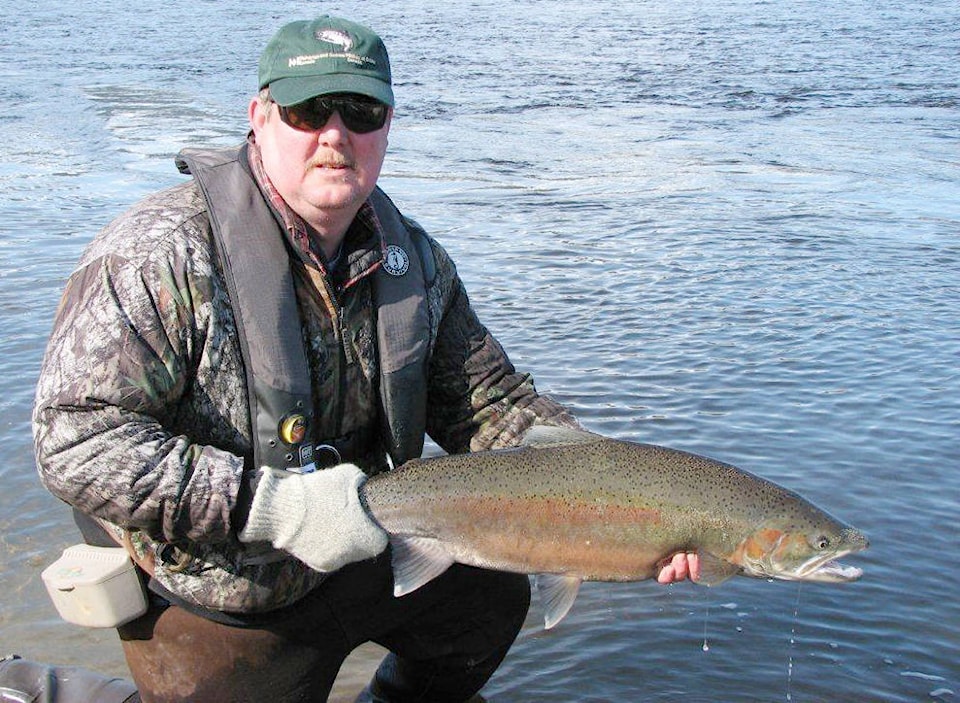A blanket of secrecy shrouds plans to cut funding to the steelhead trout breeding program at the Kitimat Hatchery.
The Sentinel learned at the District of Kitimat’s council meeting May 29 that funding for the steelhead program is being withdrawn as part of general cutbacks to hatchery programs in B.C. by Fisheries and Oceans Canada (DFO Pacific).
A visibly distressed councillor Larry Walker, who added the item to the meeting agenda, said the reduction of the breeding program would have a great impact on Kitimat.
“This is a big item for us. (Steelhead fishing) is part of our shoulder tourism season from February through to May. People come from all over to fish our steelhead because you’re able to retain one as a trophy. I don’t know what DFO is thinking,” said Walker.
He suggested the delegation from the District of Kitimat going to attend the Federation of Canadian Municipalities annual conference in Ottawa last week try to meet with the DFO.
“We have to ask them why they’re trying to take what little we have away from us, say to them ‘what are you trying to do, kill Kitimat?’” said Walker. “We have to change the powers-that-be’s mindsets so that we can retain these fisheries. Once we lose it we will never get it back.”
A motion was passed that the DoK communicate with other municipalities in the north west that will also be affected by the cutbacks.
Mayor Phil Germuth said despite the short notice, he agreed that an attempt be made to request a meeting with the DFO while the delegation was in Ottowa.
An attempt to get information from the Kitimat hatchery was immediately thwarted and any questions regarding the cutbacks were referred to the DFO’s communications advisor in Vancouver, Athina Vazeos.
When contacted, Vazeos replied to a list of questions specific to the Kitimat Hatchery, with a broad statement relating to the overall program cutbacks in the province.
She said the cutbacks formed part of the 2016 budget - the salmon breeding program, or SEP (Salmonid Enhancement Program) is funded federally, while breeding programs for steelhead and cutthroat trout are funded provincially.
“Following Budget 2016, Fisheries and Oceans Canada and the Canadian Coast Guard conducted a thorough review of programs and services to determine if our work was aligned with our core mandate or if there were options for reallocation,” said Vazeos.
She said the SEP “is undergoing reductions to better align with DFO’s core mandate in terms of regulatory responsibilities”.
She added that three of the SEP’s elements aren’t well aligned with DFO’s legislative and regulatory responsibilities, including the education and technical support contracts, resource restoration units and the production of steelhead and cutthroat trout at SEP hatcheries in the province.
“Although sport anglers value steelhead and cutthroat trout, the production of these two species has low alignment to DFO’s core mandate as those species are managed by the province,” said Vazeos. “The DFO remains committed to the conservation of wild Pacific salmon and the broader SEP, which this year, will receive $27 million in federal funding.”
She added that the SEP supports the DFO’s management objectives by producing salmon for three different purposes; harvest, stock assessment and conservation.
The DFO website refers to the hatchery as attracting anglers “from around the world to fish in the Douglas Channel and Kitimat rivers, anglers that contribute to the local economy”.
“Thanks to the hatchery’s enhanced steelhead, the Kitimat River is the only location in northern British Columbia where steelhead harvesting is permitted.”
Local fishing charter operator and Sentinel columnist Tracey Hittel said cutbacks would inevitably affect staffing at the hatchery.
“Perhaps the hatchery wants to increase salmon production, as it’s only at half capacity,” said Hittel.
Don Dillabough, who has fished along the Kitimat River since he was a young boy, became a steelhead program volunteer in 2003.
This involves catching wild steelhead and keeping them alive until they are collected by hatchery staff.
The wild steelheads are then taken to the hatchery where they are used to breed young fish, which are then released back into the river after two years.
The hatchery fish can be differentiated from the wild steelhead because the adipose fin (the soft, fleshy fin found on the back of the fish) is clipped before they are released into the river.
Volunteers who catch hatchery steelheads are required to return them to the water immediately.
Dillabough enjoys catching the steelhead so much that he specially takes two weeks off from work every year.
“They’re unique fish and they’re fun to catch. They behave completely different to salmon - they chase and jump,” said Dillabough.
He said the steelhead are so unique that people travel from all over the province every year to Kitimat to come and catch the fish.
Dillabough added that when the Kitimat Hatchery dropped the cutthroat program, the number of fish started dropping in the river.
“You’re lucky if you can still catch a cutthroat. The stocks of steelhead will also drop as people carry on catching them,” said Dillabough.
“What’s more, this doesn’t just affect Kitimat - this affects a lot of other hatcheries in northern B.C.”
As yet Vazeos has not replied to emailed questions requesting specific information about how the cutbacks would affect the Kitimat hatchery.
